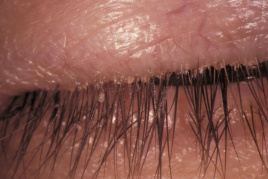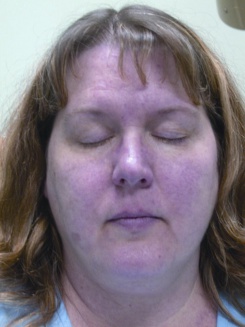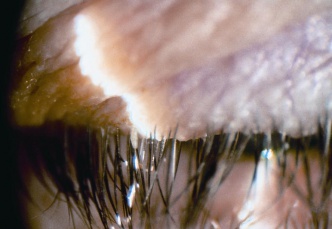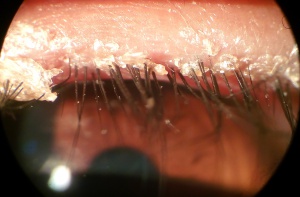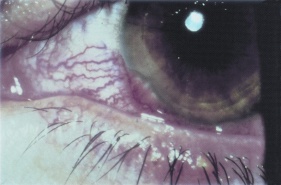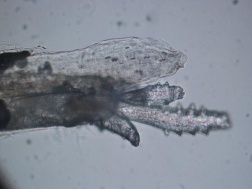Blepharitis
All content on Eyewiki is protected by copyright law and the Terms of Service. This content may not be reproduced, copied, or put into any artificial intelligence program, including large language and generative AI models, without permission from the Academy.
Disease Entity
2015 ICD-9-CM
- 373.0 Blepharitis
2010 ICD-10
- H01.0
Introduction
Blepharitis, an inflammatory condition of the eyelid margin, is a common cause of ocular discomfort and irritation in all age and ethnic groups. While generally not sight-threatening, it can lead to permanent alterations in the eyelid margin or vision loss from superficial keratopathy, corneal neovascularization, and ulceration.[1][2][3][4][5]
Blepharitis can be divided into anterior and posterior according to anatomic location, although there is considerable overlap and both are often present. Anterior blepharitis affects the eyelid skin, base of the eyelashes, and the eyelash follicles and includes the traditional classifications of staphylococcal and seborrheic blepharitis. Posterior blepharitis affects the meibomian glands and gland orifices and has a range of potential etiologies, the primary cause being meibomian gland dysfunction (MGD).[1][2][3][5]
While the etiology of blepharitis is complex and not fully understood, bacteria and inflammation are believed to contribute to the pathology. Long-term management of symptoms may include daily eyelid cleansing routines and the use of therapeutic agents that reduce infection and inflammation.[1][2][3]
Epidemiology
Blepharitis is one of the most common ocular disorders encountered in clinical practice. In a survey of US ophthalmologists and optometrists, 37% to 47% of patients seen by those surveyed had signs of blepharitis.[6] Apart from some regional studies, however, few epidemiologic data exists that estimate its true prevalence in the general population. A recent cross-sectional study in Spain based on a randomly selected sample population reported rates of asymptomatic and symptomatic meibomian gland dysfunction of 21.9% and 8.6% of individuals, respectively.[7]
Blepharitis can affect all age and ethnic groups.[2][3][6] One single-center study of 90 patients with chronic blepharitis found that the mean age of patients was 50 years.[8] Compared with patients with other forms of blepharitis, patients with staphylococcal blepharitis were found to be relatively younger (42 years old) and mostly female (80%).[9][10]
Risk Factors & Associated Conditions
Dry Eye
Dry eye has been reported to be present in 50% of patients with staphylococcal blepharitis.[9][10] Conversely, in a series of 66 patients with dry eye, 75% were reported to have staphylococcal conjunctivitis or blepharitis.[11] It has been postulated that a decrease in local lysozyme and immunoglobulin levels associated with tear deficiency may alter resistance to bacteria, predisposing patients to the development of staphylococcal blepharitis.[12]
Approximately 25% to 40% of patients with seborrheic blepharitis and MGD also have dry eye.[9] This may result from increased tear film evaporation due to a deficiency in the lipid component of the tears as well as reduced ocular surface sensation.[4]
Dermatologic Conditions
Acne rosacea has been reported in 20% to 42% of patients with all types of blepharitis.[9][13][14] Characteristic facial skin findings include erythema, telangiectasias, papules, pustules, and prominent sebaceous glands. Severe cases of both acne rosacea and blepharitis can lead to a severe periorbital erythematous edema known as Morbihan Syndrome.[15][16][17][18] This edema is granulomatous in nature, thought to be due to chronic inflammation of the cutaneous vessels.[17][18][19][20] The edema itself can be vision-obscuring.[20]
Seborrheic dermatitis, characterized by flaking and greasy skin on the scalp, retroauricular area, glabella, and nasolabial folds, has been reported in 33% to 46% of patients with blepharitis.[9][14] In one study, 95% of patients with seborrheic blepharitis also had seborrheic dermatitis.[9]
Demodicosis
Demodex infestation, characterized by cylindrical dandruff or sleeves around the eyelashes, has been found in 30% of patients with chronic blepharitis.[21] It is theorized that the infestation and waste of the mites causes blockage of the follicles and glands and/or an inflammatory response. Its role has not been firmly established since Demodex can be found with nearly the same prevalence in asymptomatic patients. Nonetheless, patients with recalcitrant blepharitis have responded to therapy directed at eradicating the Demodex mites.[21][22]
Pathophysiology
The exact pathogenesis of blepharitis is unknown, but suspected to be multifactorial.
Staphylococcal blepharitis is believed to be associated with staphylococcal bacteria on the ocular surface. In one study of ocular flora, 46% to 51% of those diagnosed with staphylococcal blepharitis had cultures positive for Staphylococcus aureus as compared to 8% of normal patients.[23][24] The mechanism by which the bacteria cause symptoms of blepharitis is not fully understood, and may include direct irritation from bacterial toxins and/or enhanced cell-mediated immunity to S. aureus.[25][26]
Seborrheic blepharitis is characterized by less inflammation than staphylococcal blepharitis but with more oily or greasy scaling. Some patients with seborrheic blepharitis also exhibit characteristics of MGD.[4]
Meibomian gland dysfunction is characterized by functional abnormalities of the meibomian glands and altered secretion of meibum, which plays an important role in slowing the evaporation of tear film and smoothing the tear film to provide an even optical surface.[4][5] Both quantitative deficiencies in meibum or qualitative differences in its composition can contribute to symptoms experienced in MGD blepharitis.
Diagnosis
The diagnosis of blepharitis is usually based on a typical patient history and characteristic slit-lamp biomicroscopic findings, described below. Ancillary testing, such as conjunctival cultures, can be helpful.
Symptoms
Symptoms of chronic blepharitis may include redness, burning sensation, irritation, tearing, eyelid crusting and sticking, and visual problems such as photophobia and blurred vision. Symptoms are typically worse in the mornings and a patient may have several exacerbations and remissions.[4] Administration of a questionnaire, such as the Ocular Surface Disease Index or Dry Eye Questionnaire, may have a role in uncovering or tracking symptoms associated with ocular discomfort in MGD. [27][28]
Physical Examination
While the clinical features of the blepharitis categories can overlap, certain signs and symptoms are more commonly associated with particular subtypes.[3]
Staphylococcal blepharitis is characterized on examination by erythema and edema of the eyelid margin. Patients may exhibit eyelash loss and/or misdirection, signs that are rarely seen with other types of blepharitis.[1][2][3] Other signs may include telangiectasia on the anterior eyelid, hard scales/collarettes encircling the lash base, and corneal changes (infiltrates, phlyctenules). In severe and long-standing cases, eyelid ulceration and corneal scarring may occur.[3][4]
Seborrheic blepharitis is differentiated by less erythema, edema, and telangiectasia of the lid margins as compared to staphylococcal blepharitis, but an increased amount of oily scale and greasy crusting on the lashes.[2][10]
Posterior blepharitis/MGD, often associated with rosacea, may be seen clinically by examining the posterior eyelid margin. The meibomian glands may appear capped with oil, be dilated, or be visibly obstructed. The secretions of the glands are usually turbid and thicker than normal. Telangiectasias and lid scarring may also be present in this area. Chalazia may be a cause or consequence of MGD.[2][3]
In all forms of blepharitis, examination of the tear film may show instability and rapid evaporation.[1][3][4][5] The method most frequently used to assess tear film stability is to measure the tear break-up time (TBUT), i.e., the time interval between a complete blink and the first appearance of a dry spot in the pre-corneal tear film after fluorescein instillation. There is general agreement that a TBUT shorter than 10 seconds reflects tear film instability.[29]
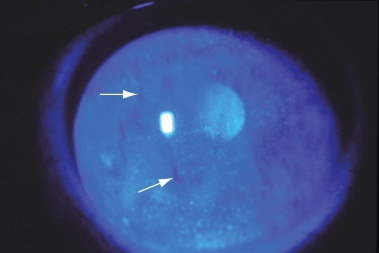
Diagnostic Procedures
There are no specific clinical diagnostic tests for blepharitis, however, cultures of the eyelid margins may be indicated for patients who have recurrent anterior blepharitis with severe inflammation, as well as for patients who are not responding to therapy.[4]
Measurement of tear osmolarity may be useful in diagnosing concurrent dry eye syndrome. A previous meta-analysis found that tear osmolarity of 316 mOsm/L or greater yields a sensitivity of 59%, specificity of 94%, and overall predictive accuracy of 89% for the diagnosis of dry eye syndrome.[30] However, measurement of tear osmolarity has a limited role in differentiating between aqueous deficient and evaporative dry eye.[31]
Microscopic evaluation of epilated eyelashes may reveal Demodex mites, which have been implicated in some cases of chronic blepharoconjunctivitis. The specimen is prepared for microscopy by placing the explanted eyelashes on a glass slide, adding a drop of fluorescein, and securing the specimen beneath a cover slip.[32]
A biopsy of the eyelid may be indicated to exclude the possibility of carcinoma in cases of marked asymmetry, resistance to therapy, or unifocal recurrent chalazia that do not respond well to therapy.[33]
Differential Diagnosis [1]
| Condition | Entity |
|---|---|
| Bacterial infections |
|
| Viral infections |
|
| Parasitic infection |
|
| Immunologic conditions |
|
| Dermatoses |
|
| Benign eyelid tumors |
|
| Malignant eyelid tumors |
|
| Trauma |
|
| Toxic conditions |
|
Management
Blepharitis is a chronic condition with frequent exacerbation. Currently, standard therapy is directed at control of symptoms and inflammatory signs. A recent Cochrane review evaluated 34 chronic blepharitis intervention studies and found no strong evidence to suggest that any of the studied treatments resulted in a cure.[2]
Though the pathophysiology of anterior and posterior blepharitis may be different, the treatment options are similar. Current practice is such that patients generally are offered treatment if they report discomfort or experience visual symptoms.
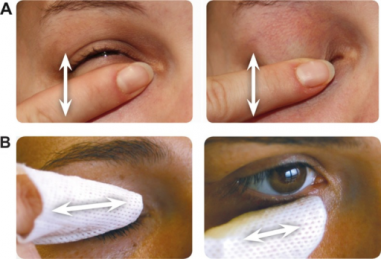
General Treatment
An initial step in treating patients who have blepharitis is to recommend eyelid hygiene, which includes warm compresses, eyelid massage, and eyelid scrubs.[1][2][3][4] One regimen is to apply warm compresses to the eyelids for several minutes, two to four times daily to soften adherent scurf and scales and/or warm the meibomian secretions. Vertical eyelid massage can be performed to express meibomian secretions.
Many ophthalmologists recommend a gentle regimen of lid hygiene with baby shampoo. But, aside from its color and fragrance—both of which can be sensitizing—baby shampoo contains soaps that can destabilize the tear film and damage the ocular surface. Johnson & Johnson Consumer Care Baby stated, “We do not advise using the product in the eye area.” Notably, in 2004, the American Journal of Contact Dermatitis named Cocamidopropyl betaine, the primary ingredient in Johnson & Johnson Baby Shampoo, as the Contact Allergen of the Year. [35] Also, the College of Optometrists Clinical Management Guidelines stated that there was insufficient evidence to make any recommendation based on the relative effectiveness of different methods of lid hygiene. [36] While some individuals with chronic blepharitis may benefit from eyelid hygiene, the optimal form of hygiene for each subtype remains unclear. Until more conclusive evidence emerges, baby shampoo should not be recommended as a preferred treatment.
As blepharitis is a chronic disease, eyelid hygiene must be performed even after an acute exacerbation has resolved. Adverse effects of lid hygiene treatment are few but may include mechanical irritation from overly vigorous scrubbing or sensitivity reaction to the detergents used.[2][37]
Medical Therapy
Topical Antibiotics
For anterior blepharitis, topical antibiotics have been found useful for symptomatic relief and effective in eradicating bacteria from the eyelid margins.[2][3][38][39] Topical ointments such as bacitracin or erythromycin may be applied to the eyelid margins one or more times daily or before bed for two to eight weeks or until symptoms resolve. Some patients require chronic therapy in order to remain symptom free.[2][24]
Oral Antibiotics
Oral antibiotics such as tetracyclines (tetracycline, doxycycline, minocycline) or macrolides (erythromycin, azithromycin) are recommended for patients with MGD not controlled with eyelid hygiene or patients with associated rosacea.[1][2][3] Treatment can be tailored to response, and therapy can be intermittently discontinued and reinstated, based on the severity of the patient’s blepharitis and tolerance for the medication, and to allow recolonization of normal flora.[1]
The rationale for the use of tetracyclines is based in part on small clinical trials that report efficacy of the drugs in improving symptoms in patients with ocular rosacea and improving tear break-up time in patients with rosacea and MGD.[40][41][42] In such cases, oral antibiotics are used in large part for their anti-inflammatory and lipid-regulating properties.[43]
The tetracyclines and related drugs have several well-documented side effects, including photosensitization, gastrointestinal upset, and vaginitis.[1] Tetracyclines should not be given to pregnant or nursing women, children under 10 years of age, or patients sensitive to this class of drugs. Azithromycin should be used cautiously in patients with cardiovascular problems, as it may lead to serious irregularities in heart rhythm.[1][3]
Steroids
Short courses of topical steroids have been found beneficial for symptomatic relief in cases with clinically significant ocular inflammation.[1][2][3] Corticosteroid drops or ointment can be applied several times daily to the eyelids or ocular surface until the inflammation is reduced. These agents can be tapered over time and gradually discontinued, then reintroduced as needed. The minimally effective dose with the shortest duration of use should be used to reduce the risk of increased intraocular pressure and cataracts. Using a site-specific corticosteroid, such as loteprednol etabonate, or corticosteroids with limited ocular penetration, such as fluorometholone, may minimize these adverse effects.[1]
Topical combinations of an antibiotic and corticosteroid such as tobramycin/dexamethasone or tobramycin/loteprednol have been shown to be useful, especially since lid and ocular surface bacterial infection and inflammation commonly coexist.[2]
In three recent prospective studies, topical cyclosporine 0.05% was shown to result in significantly greater improvement in eyelid margin inflammatory signs than the comparator group: artificial tears[44][45] or tobramycin/dexamethasone ophthalmic suspension.[46] Further evaluation is pending in larger-scale clinical trials.
Topical Lubrication
Since many blepharitis patients have evaporative and aqueous tear deficiency, artificial tears may improve symptoms when used as an adjunct to eyelid cleansing and medications. If artificial tears are used more than four times per day, preservative-free tears should be used to avoid toxicity.[3][43]
Other
Increased intake of essential fatty acids, specifically omega-3 fatty acid, was recommended by the International Workshop on MGD for cases of mild-to-severe MGD.[43] These essential fatty acids may be beneficial to anti-inflammatory processes and have also been associated with reduced dry eye symptoms. However, the Dry Eye Assessment and Management (DREAM) Study Research Group published a randomized controlled trial in 2018 that reported that 3000mg of n-3 fatty acids for 12 months did not have significantly better outcomes than those who were assigned to receive placebo.[47]
For patients with Demodex infestation who have failed conventional treatment methods, 50% tea-tree oil eyelid scrubs and daily tea-tree-oil shampoo scrubs have been shown to be of some benefit when used for a minimum of 6 weeks.[48] Oral ivermectin has also been reported to be useful in some cases of recalcitrant Demodex blepharitis.[49][50]
LipiFlow® (TearScience®, Morrisville, NC, USA) is a thermal pulsation system that applies heat and pressure to the eyelid tissue simultaneously to express the meibomian glands.[51] A small, prospective study found that a single 12-minute treatment with the Lipiflow system gave rise to significant improvement in both signs (based on tear break-up time, corneal fluorescein staining, and meibomian gland secretion scores) and symptoms (based on Ocular Surface Disease Index and standard patient evaluation of eye dryness scores) of meibomian gland dysfunction for up to one year.[52] In 2013, a prospective, randomized controlled study showed a single Lipiflow treatment was at least as effective as a 3-month, twice- daily lid margin hygiene regimen for MGD in regards to subjective symptoms, but there was no significant difference in expressible meibomian glands, TBUT, or Schirmer's test results.[53] In a 2016 controlled study of Asian patients only, Lipiflow showed only modest benefit in TBUT and MG function at 3 months compared to a control group.[54]
Intraductal meibomian gland probing to reopen MG orfices mechanically has been reported to provide rapid and lasting symptom relief in a case series of patients with obstructive MGD, but can be uncomfortable and inconvenient for patients.[55]
Since 2002, some studies have noted that patients undergoing intense pulse light therapy (IPL) for skin conditions such as rosacea also noted a benefit in their MGD and dry eye symptoms.[56] IPL is typically administered every 2 to 4 weeks for at least 3 sessions, and may improve subjective and objective MGD and dry eye parameters.[57] [58]
Those who develop edema or Morbihan Syndrome may benefit from various medical therapies including isotretinoin and ketotifen or clofazimine, or prolonged antibiotic therapy. Refractory cases may require surgical excision of edematous tissue, as well as CO2 laser ablation therapies.[59][60][61][62][63][64]
Prognosis
Blepharitis is a chronic condition that has periods of exacerbation and remission. Patients should be informed that symptoms can frequently be improved but are rarely eliminated. Rarely, severe blepharitis can result in permanent alterations in the eyelid margin or vision loss from superficial keratopathy, corneal neovascularization, and ulceration.[1][2][3][4][5] Those with blepharitis should be monitored for eyelid edema that may be impacting visual acuity on follow-up visits. Patients with an inflammatory eyelid lesion that appears suspicious for malignancy should be referred to an appropriate specialist.
Additional Resources
- Boyd K, Huffman JM, Turbert D. Blepharitis. American Academy of Ophthalmology. EyeSmart/Eye health. https://www.aao.org/eye-health/diseases/blepharitis-list. Accessed January 06, 2023.
- Mukamal R, Van Gelder RN, Herz NL. Microbiome of the Eye. American Academy of Ophthalmology. EyeSmart/Eye health. https://www.aao.org/eye-health/anatomy/microbiome-of-eye-list. Accessed January 06, 2023.
- Turbert D. Crusty Eyelid or Eyelashes. American Academy of Ophthalmology. EyeSmart/Eye health. https://www.aao.org/eye-health/symptoms/crusty-eyelid-eyelashes-list. Accessed January 06, 2023.
- Boyd K, Pagan-Duran B. Sleep Crust. American Academy of Ophthalmology. EyeSmart/Eye health. https://www.aao.org/eye-health/diseases/sleep-crust. Accessed January 06, 2023.
References
- ↑ Jump up to: 1.00 1.01 1.02 1.03 1.04 1.05 1.06 1.07 1.08 1.09 1.10 1.11 1.12 1.13 American Academy of Ophthalmology. Preferred Practice Pattern: Blepharitis. October 2012 revision. Available at: http://one.aao.org/preferred-practice-pattern/blepharitis-ppp--2013. Accessed November 10, 2014.
- ↑ Jump up to: 2.00 2.01 2.02 2.03 2.04 2.05 2.06 2.07 2.08 2.09 2.10 2.11 2.12 2.13 2.14 2.15 Lindsley K, Matsumura S, Hatef E, Akpek EK. Interventions for chronic blepharitis. Cochrane Database Syst Rev. 2012;5:CD005556.
- ↑ Jump up to: 3.00 3.01 3.02 3.03 3.04 3.05 3.06 3.07 3.08 3.09 3.10 3.11 3.12 3.13 3.14 3.15 Pflugfelder SC, Karpecki PM, Perez VL. Treatment of blepharitis: recent clinical trials. Ocul Surf. 2014;12(4):273-84.
- ↑ Jump up to: 4.0 4.1 4.2 4.3 4.4 4.5 4.6 4.7 4.8 4.9 Skuta GL, Cantor LB, Cioffi GA, et al, eds. American Academy of Ophthalmology Basic Clinical Science Course: External Disease and Cornea. Vol. 8. San Francisco, CA: American Academy of Ophthalmology; 2013;44-50, 58-66.
- ↑ Jump up to: 5.0 5.1 5.2 5.3 5.4 Kanski JJ, Bowling B. Clinical Ophthalmology: A Systemic Approach (Seventh Edition). New York: Elsevier Saunders; 2011;34-39.
- ↑ Jump up to: 6.0 6.1 Lemp MA, Nichols KK. Blepharitis in the United States 2009: a survey-based perspective on prevalence and treatment. Ocular Surface 2009;7(Suppl 2):S1–14.
- ↑ Viso E, Rodríguez-Ares MT, Abelenda D, et al. Prevalence of asymptomatic and symptomatic meibomian gland dysfunction in the general population of Spain. Invest Ophthalmol Vis Sci 2012;53:2601-6.
- ↑ Schaumberg DA, Nichols JJ, Papas EB, et al. The International Workshop on Meibomian Gland Dysfunction: report of the subcommittee on the epidemiology of, and associated risk factors for, MGD. Invest Ophthalmol Vis Sci 2011;52:1994-2005.
- ↑ Jump up to: 9.0 9.1 9.2 9.3 9.4 9.5 McCulley JP, Dougherty JM, Deneau DG. Classification of chronic blepharitis. Ophthlamology 1982;89:1173-80.
- ↑ Jump up to: 10.0 10.1 10.2 McCulley JP, Dougherty JM. Blepharitis associated with acne rosacea and seborrheic dermatitis. International Ophthalmology Clinics 1985;25(1):159–72.
- ↑ Baum J. Clinical manifestations of dry eye states. Trans Ophthalmol Soc U K 1985;104(Pt 4):415-23.
- ↑ Bowman RW, Dougherty JM, McCulley JP. Chronic blepharitis and dry eyes. Int Ophthalmol Clin 1987;27:27-35.
- ↑ Groden LR, Murphy B, Rodnite J, Genvert GI. Lid flora in blepharitis. Cornea 1991;10(1):50–3.
- ↑ Jump up to: 14.0 14.1 Huber-Spitzy V, Baumgartner I, Bohler-Sommeregger K, Grabner G. Blepharitis - a diagnostic and therapeutic challenge. A report on 407 consecutive cases. Graefe’s Archive for Clinical and Experimental Ophthalmology 1991;229(3):244–7.
- ↑ Helm KF, et al. A clinical and histopathologic study of granulomatous rosacea. J Am Acad Dermatol 1991;25:1038.
- ↑ Wilkin J, et al. Standard classification of rosacea: report of the National Rosacea Society expert committee on the classification and staging of rosacea. J Am Acad Dermatol 2002;46:584.
- ↑ Jump up to: 17.0 17.1 Nagasaka T, et al. Persistent lymphedema in Morbihan disease: formation of perilymphatic epithelioid granulomas as a possible pathogenesis. Clin Exp Dermatol 2008;33:764.
- ↑ Jump up to: 18.0 18.1 Hu SW, Robinson M, Meehan SA, Cohen DE. Morbihan disease. Dermatol Online J. 2012;18:27–27.
- ↑ Wohlrab J, et al. Persistent erythema and edema of the mid third and upper aspect of the face (morbus morbihan): evidence of hidden immunologic contact urticaria and impaired lymphatic drainage. J Am Acad Dermatol 2005;52:592.
- ↑ Jump up to: 20.0 20.1 Lai TF, et al. Rosacea lymphedema of the eyelid. Acta Ophthalmol Scand 2004;82:765.
- ↑ Jump up to: 21.0 21.1 Kemal M, Sumer Z, Toker MI, et al. The prevalence of Demodex folliculorum in blepharitis patients and the normal population. Ophthalmic Epidemiol 2005;12:287-90.
- ↑ Gao YY, Di Pascuale MA, Li W, et al. High prevalence of Demodex in eyelashes with cylindrical dandruff. Invest Ophthalmol Vis Sci 2005;46:3089-94.
- ↑ Dougherty JM, McCulley JP. Comparative bacteriology of chronic blepharitis. British Journal of Ophthalmology 1984;68(8):524–8.
- ↑ Jump up to: 24.0 24.1 McCulley JP. Blepharoconjunctivitis. International Ophthalmology Clinics 1984;24(2):65–77.
- ↑ Valenton MJ, Okumoto M. Toxin-producing strains of Staphylococcus epidermidis (albus). Isolates from patients with staphylococcic blepharoconjunctivitis. Archives of Ophthalmology 1973;89(3):186–9.
- ↑ Ficker L, Ramakrishnan M, Seal D, Wright P. Role of cell-mediated immunity to staphylococci in blepharitis. American Journal of Ophthalmology 1991;111(4):473–9.
- ↑ Schiffman RM, Christianson MD, Jacobsen G, Hirsch JD, Reis BL. Reliability and validity of the Ocular Surface Disease Index. Arch Ophthalmol. 2000;118(5):615–621.
- ↑ Begley CG, Caffery B, Nichols K, Mitchell GL, Chalmers R.; DREI study group: results of a dry eye questionnaire from optometric practices in North America. Adv Exp Med Biol. 2002;506:1009–1016.
- ↑ Savini G, Prabhawasat P, Kojima T, Grueterich M, Espana E, Goto E. The challenge of dry eye diagnosis. Clin Ophthalmol. 2008;2(1):31-55.
- ↑ Tomlinson A, Khanal S, Ramaesh K, et al. Tear film osmolarity: determination of a referent for dry eye diagnosis. Invest Ophthalmol Vis Sci. 2006;47(10):4309–4315.
- ↑ Khanal S, Tomlinson A, Diaper CJ. Tear physiology of aqueous deficiency and evaporative dry eye.Optom Vis Sci. 2009;86(11):1235–1240.
- ↑ Kheirkhah A, Blanco G, Casas V, Tseng SC. Fluorescein dye improves microscopic evaluation and counting of demodex in blepharitis with cylindrical dandruff. Cornea 2007;26:697-700.
- ↑ Gilberg S, Tse D. Malignant eyelid tumors. Ophthalmol Clin North Am 1992;5:261-85.
- ↑ Benitez-del-castillo JM. How to promote and preserve eyelid health. Clin Ophthalmol. 2012;6:1689-98.
- ↑ Welling JD, Mauger TF, Schoenfield LR, Hendershot AJ. Chronic eyelid dermatitis secondary to cocamidopropyl betaine allergy in a patient using baby shampoo eyelid scrubs. JAMA Ophthalmol. 2014;132(3):357-359. doi:10.1001/jamaophthalmol.2013.6254
- ↑ https://www.college-optometrists.org/clinical-guidance/clinical-management-guidelines. Accessed 03/01/2025
- ↑ Key JE. A comparative study of eyelid cleaning regimens in chronic blepharitis. CLAO J 1996;22:209-12.
- ↑ O’Brien TP. The role of bacteria in blepharitis. Ocul Surf 2009;7(2 suppl):S21-2
- ↑ Jackson WB. Blepharitis: current strategies for diagnosis and management. Can J Ophthalmol 2008;43:170-9.
- ↑ Iovieno A, Lambiase A, Micera A, et al. In vivo characterization of doxycycline effects on tear metalloproteinases in patients with chronic blepharitis. Eur J Ophthalmol, 19:708-16, 2009.
- ↑ Quarterman MJ, Johnson DW, Abele DC, et al. Ocular rosacea. Signs, symptoms, and tear studies before and after treatment with doxycycline. Arch Dermatol, 133:49-54, 1997.
- ↑ Yoo SE, Lee DC, Chang MH. The effect of low-dose doxycycline therapy in chronic meibomian gland dysfunction. Korean J Ophthalmol, 19:258-63, 2005.
- ↑ Jump up to: 43.0 43.1 43.2 Geerling G, Tauber J, Baudouin C, et al. The international workshop on meibomian gland dysfunction: report of the subcommittee on management and treatment of meibomian gland dysfunction. Invest Ophthalmol Vis Sci 2011;52:2050-64.
- ↑ Perry HD, Doshi-Carnevale S, Donnenfeld ED, et al. Efficacy of commercially available topical cyclosporine A 0.05% in the treatment of meibomian gland dysfunction. Cornea 2006;25:171-5
- ↑ Prabhasawat P, Tesavibul N, Mahawong W. A randomized doublemasked study of 0.05% cyclosporine ophthalmic emulsion in the treatment of meibomian gland dysfunction. Cornea 2012;31:1386-93
- ↑ Rubin M, Rao SN. Efficacy of topical cyclosporine 0.05% in the treatment of posterior blepharitis. J Ocul Pharmacol Ther 2006;22:47-53
- ↑ Dry Eye Assessment and Management Study Research G, Asbell PA, et al. n-3 Fatty Acid Supplementation for the Treatment of Dry Eye Disease. N Engl J Med. 2018;378(18):1681-1690.
- ↑ Kheirkhah A, Casa V, Li W, et al. Corneal manifestations of ocular Demodex infestation. Am J Ophthalmol 2007;143:743-9.
- ↑ Filho PAN, Hazarbassanov RM, Grisolia ABD, et al. The efficacy of oral ivermectin for the treatment of chronic blepharitis in patients tested positive for Demodex spp. Br J Ophthalmol 2011;95:893-5.
- ↑ Holzchuh FG, Hida RY, Moscovici BK, et al. Clinical treatment of ocular Demodex folliculorum by systemic ivermectin. Am J Ophthalmol 2011;151:1030-4.
- ↑ Lane SS, DuBiner HB, Epstein RJ, et al. A new system, the LipiFlow, for the treatment of meibomian gland dysfunction.Cornea. 2012;31(4): 396–404.
- ↑ Greiner JV. A single LipiFlow®Thermal Pulsation System treatment improves meibomian gland function and reduces dry eye symptoms for 9 months.Curr Eye Res. 2012;37(4):272–278.
- ↑ Finis D, Hayajneh J, Konig C, Borrelli M, Schrader S, Geerling G. Evaluation of an automated thermodynamic treatment (LipiFlow(R)) system for meibomian gland dysfunction: a prospective, randomized, observer-masked trial. Ocul Surf 2014;12:146-54
- ↑ Zhao Y, Veerappan A, Yeo S, et al. Clinical Trial of Thermal Pulsation (LipiFlow) in Meibomian Gland Dysfunction With Preteatment Meibography. Eye Contact Lens 2016;42:339-46.
- ↑ Maskin SL. Intraductal meibomian gland probing relieves symptoms of obstructive meibomian gland dysfunction. Cornea 2010;29:1145-52.
- ↑ Lam PY, Shih KC, Fong PY, et al. A Review on Evidence-Based Treatments for Meibomian Gland Dysfunction. Eye Contact Lens 2020;46:3-16.
- ↑ Lam PY, Shih KC, Fong PY, et al. A Review on Evidence-Based Treatments for Meibomian Gland Dysfunction. Eye Contact Lens 2020;46:3-16.
- ↑ Wladis EJ, Aakalu VK, Foster JA, Freitag SK, Sobel RK, Tao JP, Yen MT. Intense Pulsed Light for Meibomian Gland Disease: A Report by the American Academy of Ophthalmology. Ophthalmology. 2020 Sep;127(9):1227-1233. doi: 10.1016/j.ophtha.2020.03.009. Epub 2020 Apr 21. PMID: 32327256.
- ↑ Boparai RS, Levin AM, Lelli Jr GJ. Morbihan disease treatment: two case reports and a systematic literature review. Ophthalmic Plastic & Reconstructive Surgery. 2019;35(2):126-132.
- ↑ Smith LA, Cohen DE. Successful long-term use of oral isotretinoin for the management of Morbihan disease. A case series report and review of the literature. Arch Dermatol. 2012;148(012):1395–1398.
- ↑ Mazzatenta C, et al. Solid persistent facial edema (Morbihan’s disease) following rosacea, successfully treated with isotretinoin and ketotifen. Br J Dermatol 1997;137:1020.
- ↑ Jungfer B, et al. Solid persistent facial edema of acne: successful treatment with isotretinoin and ketotifen. Dermatology 1993;187:34.
- ↑ Helander I, Aho HJ. Solid facial edema as a complication of acne vulgaris: treatment with isotretinoin and clofazimine. Acta Derm Venereol 1987;67:535.
- ↑ Bechara FG, Jansen T, Losch R, Altmeyer P, Hoffmann K.J Dermatol. 2004;31(2):113-115.


